Sir John Monash, Personal Files Book 14, 6 October - 30 November 1916, Part 16
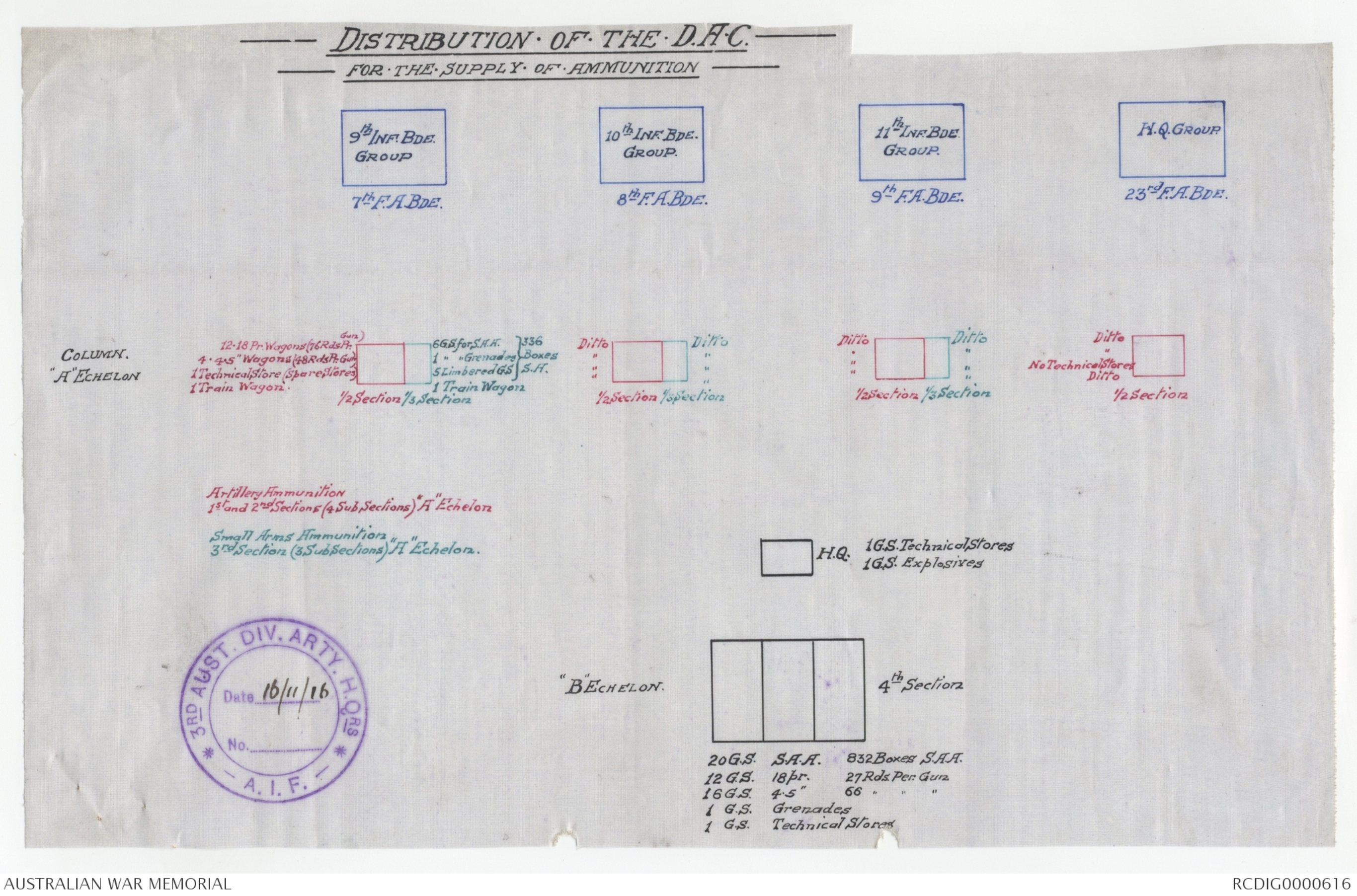
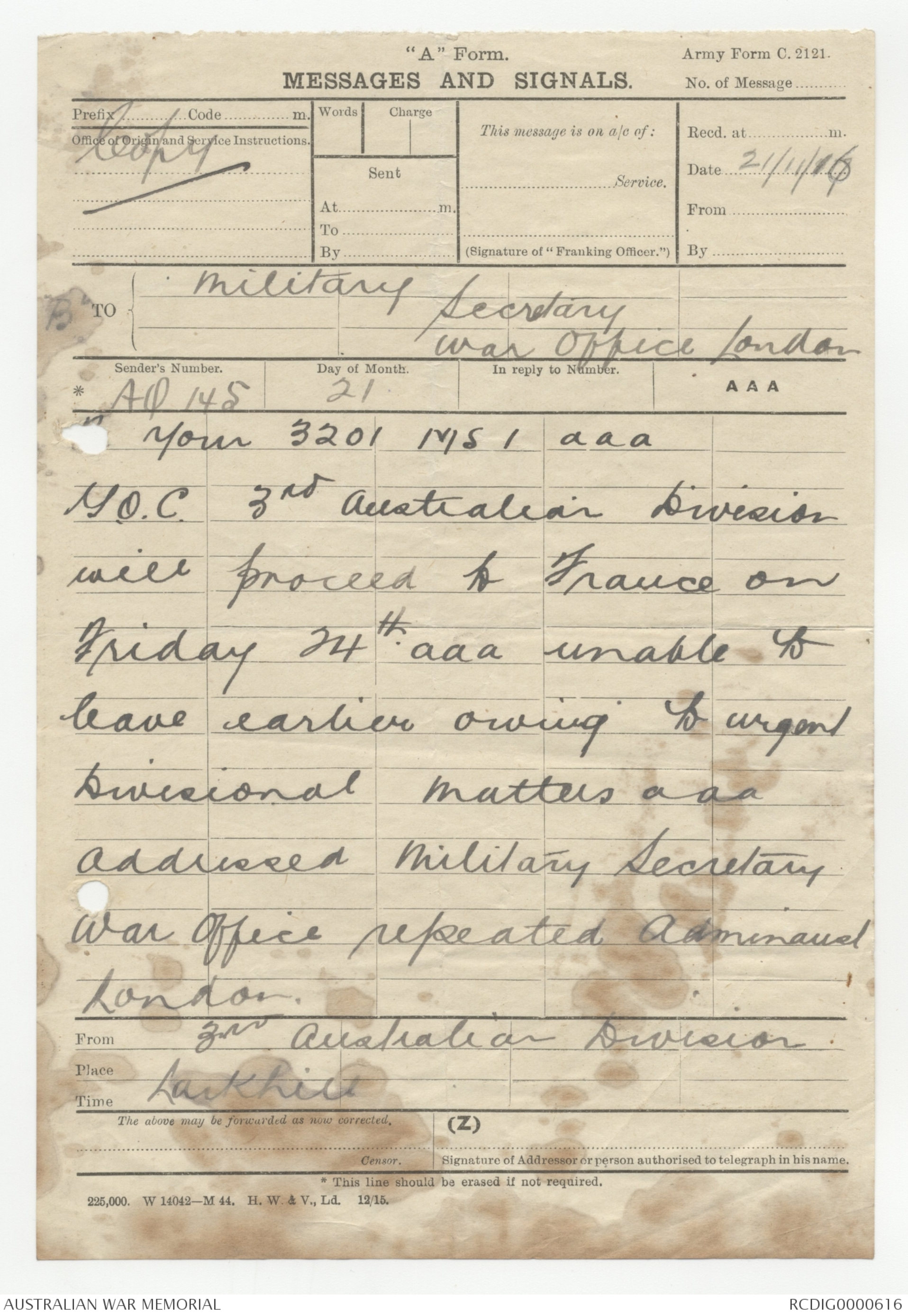
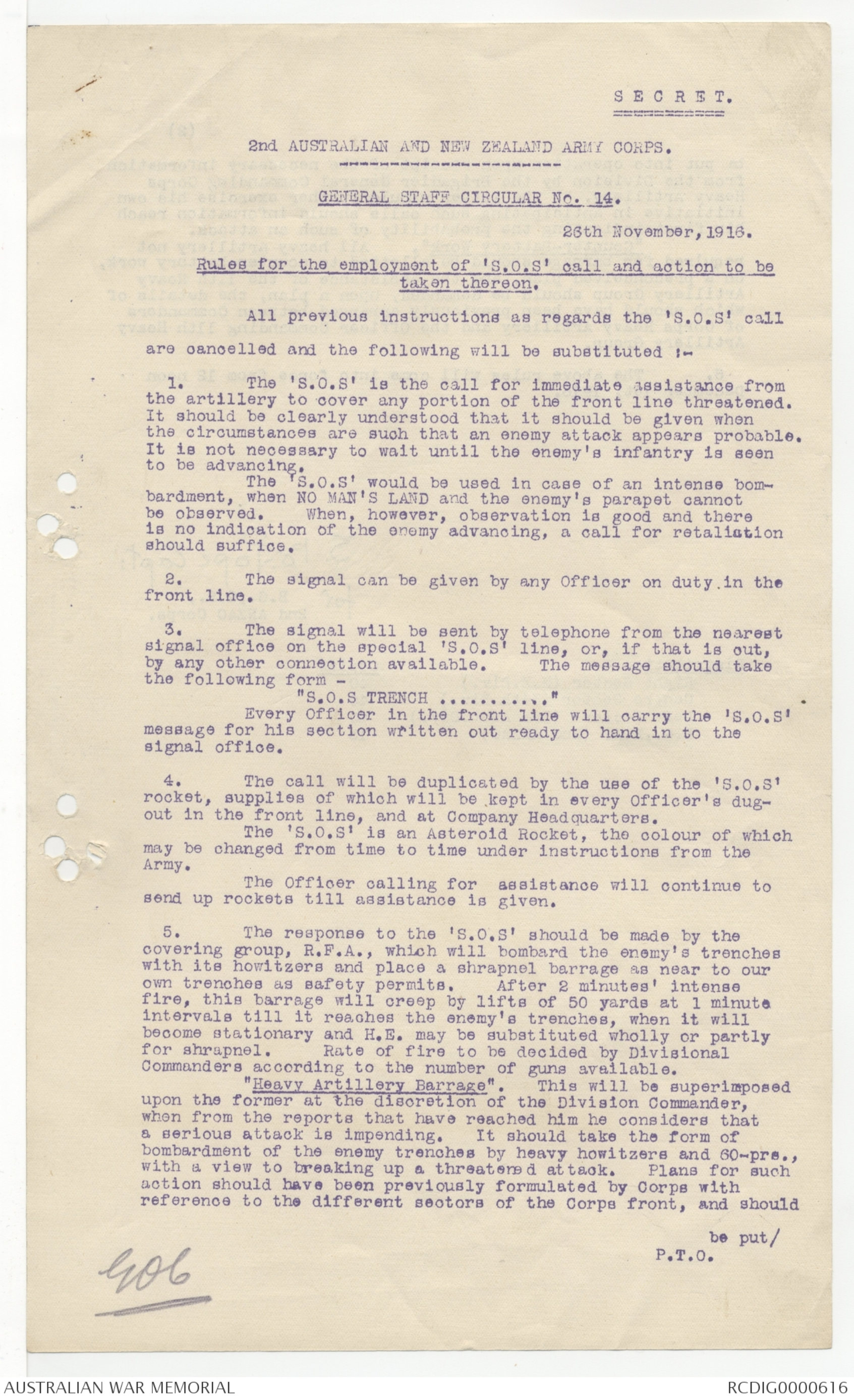
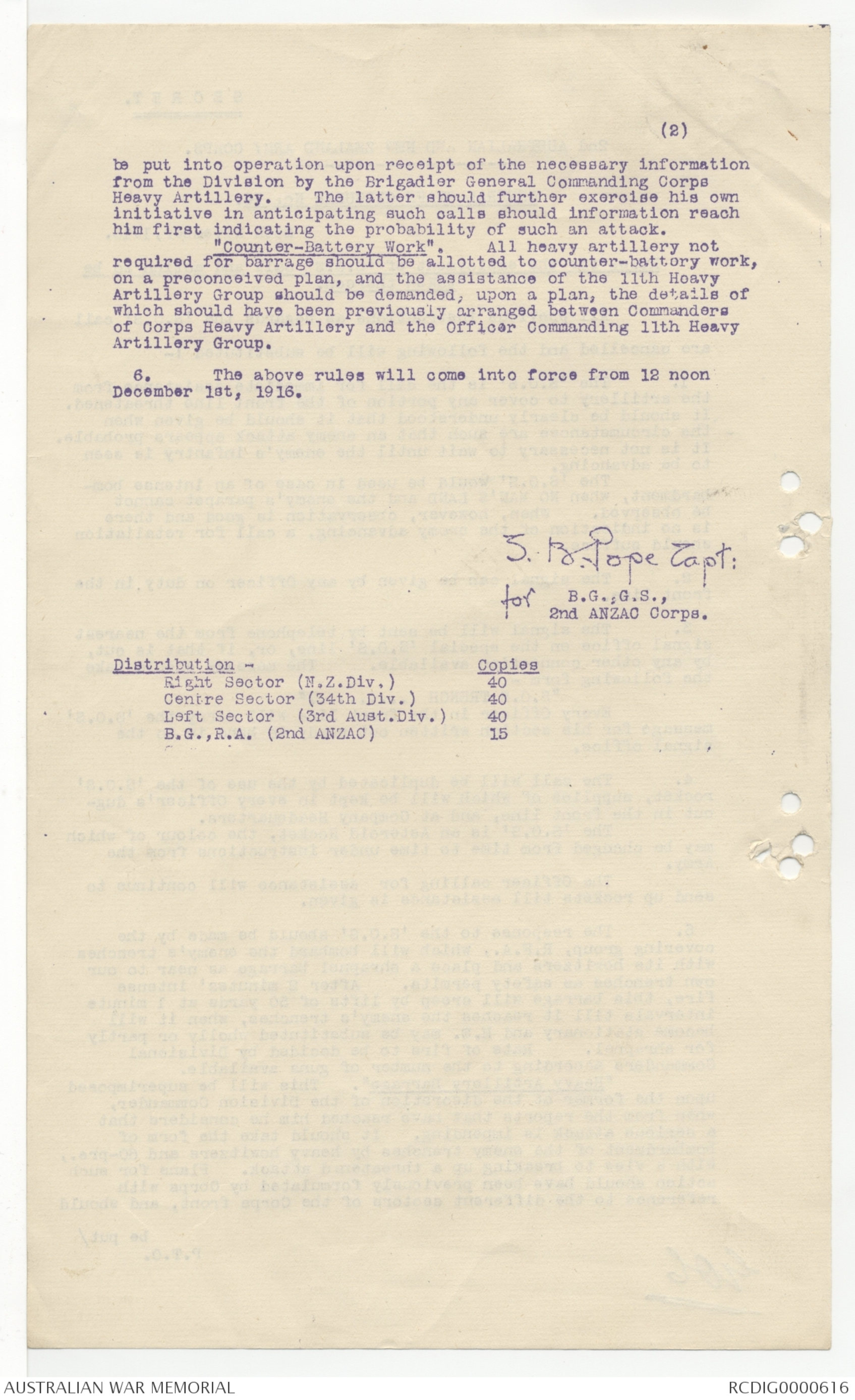
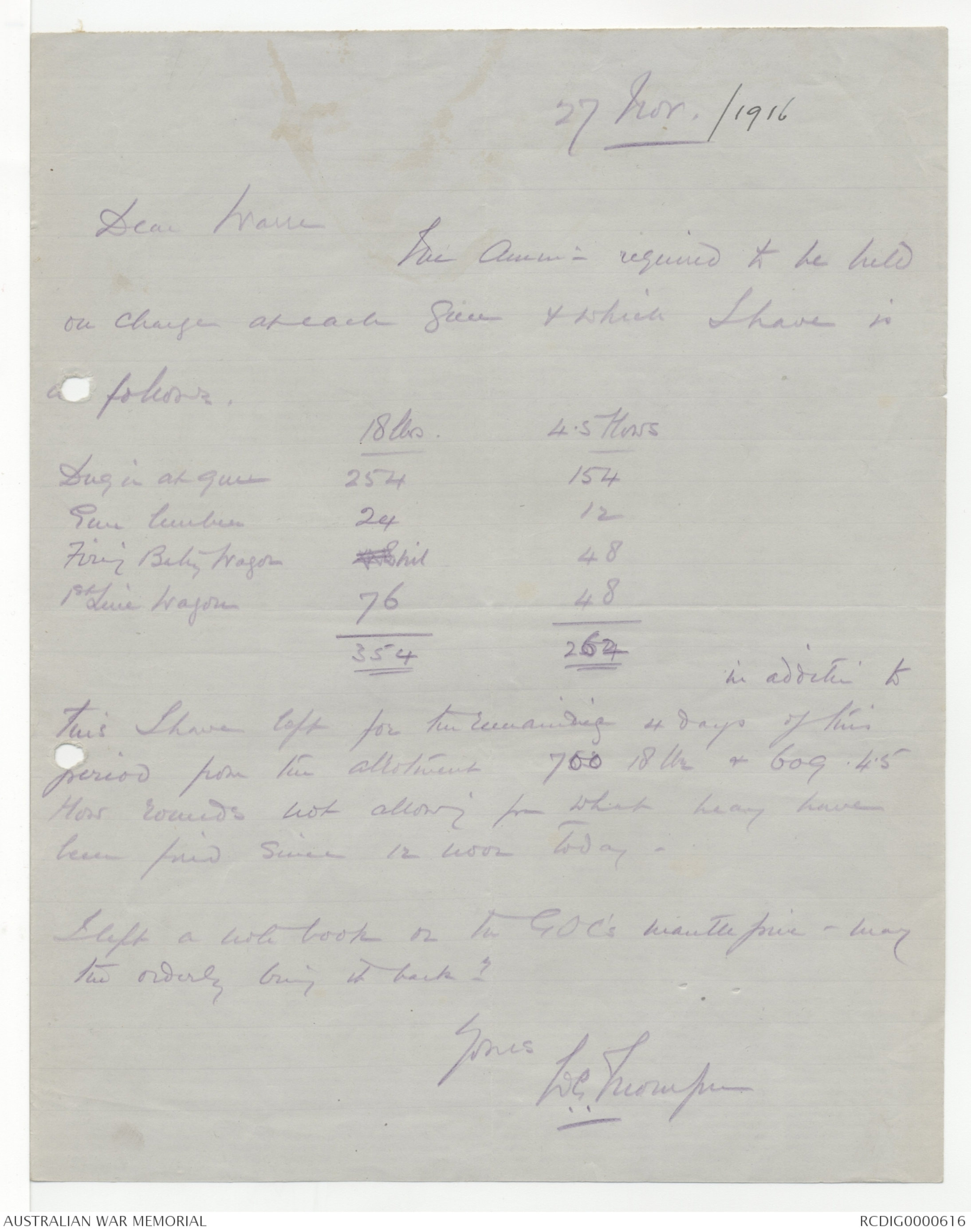
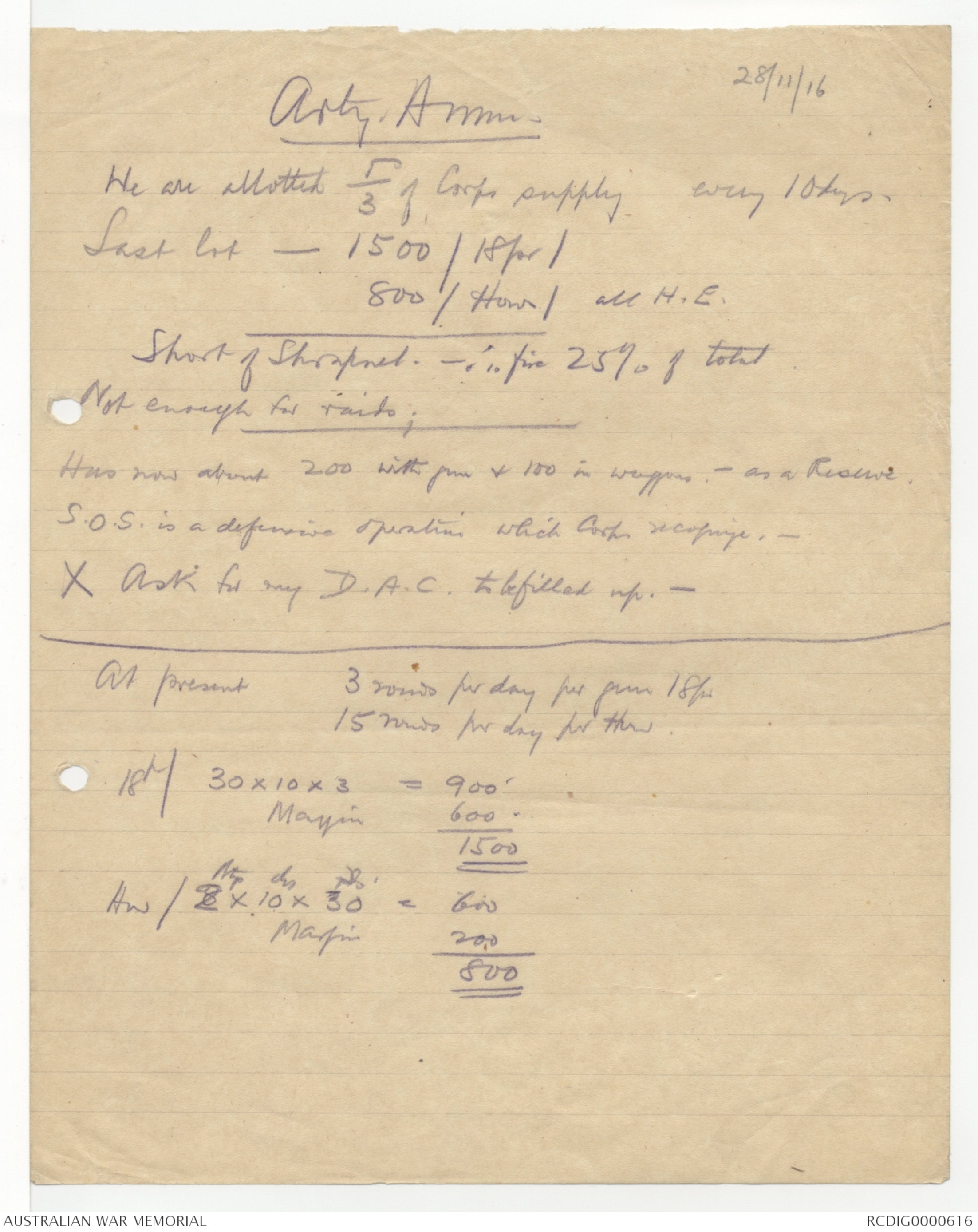
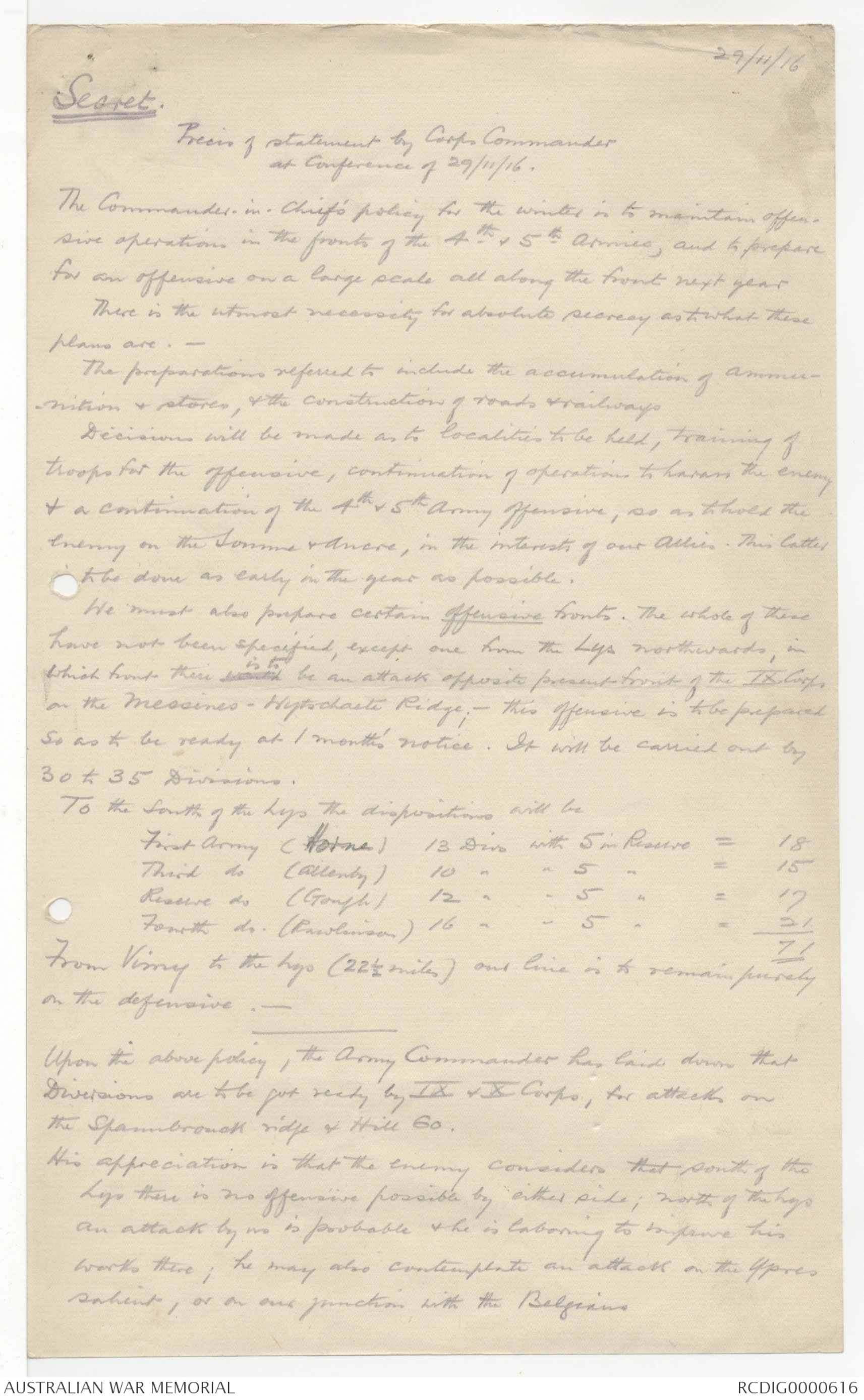
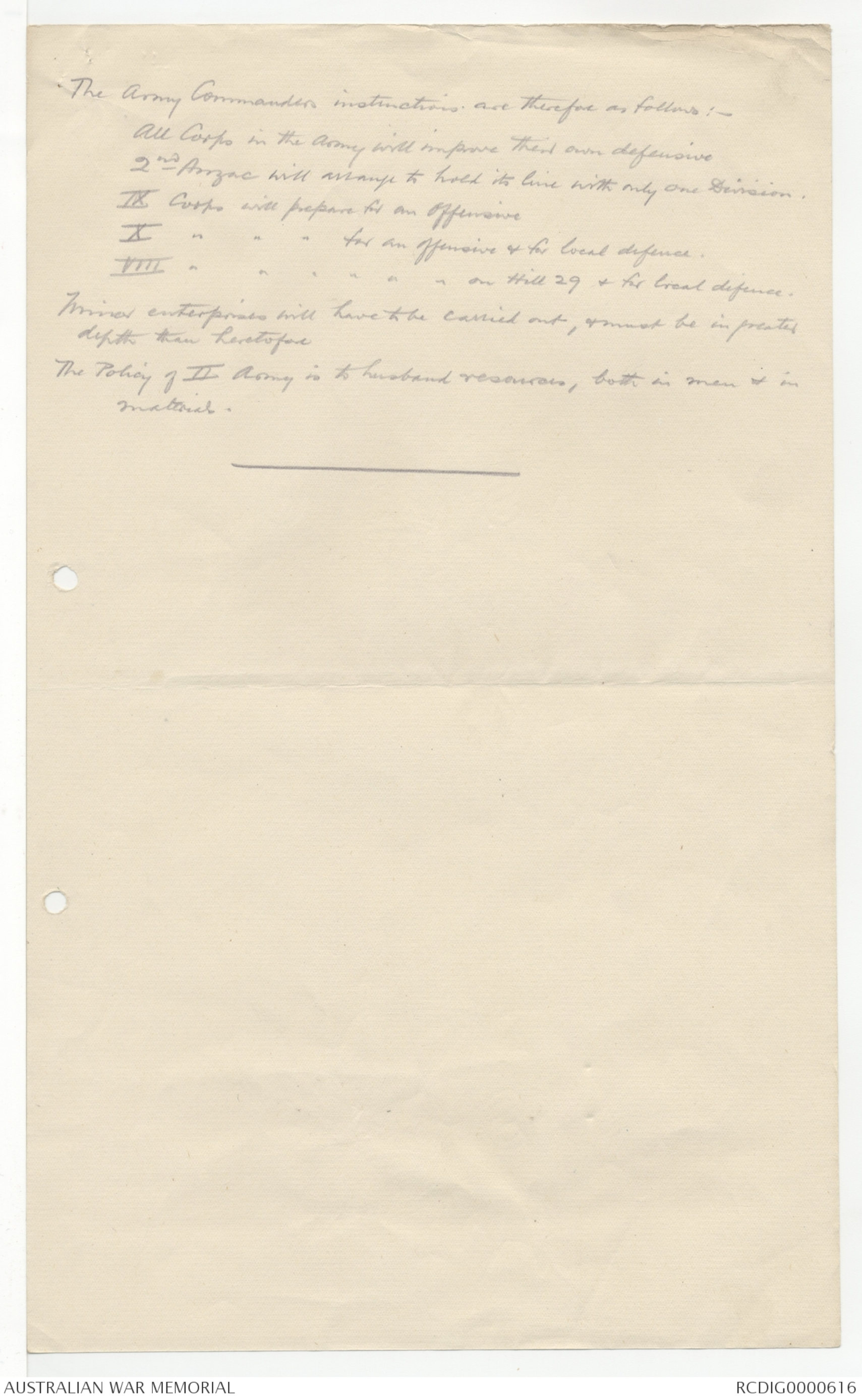
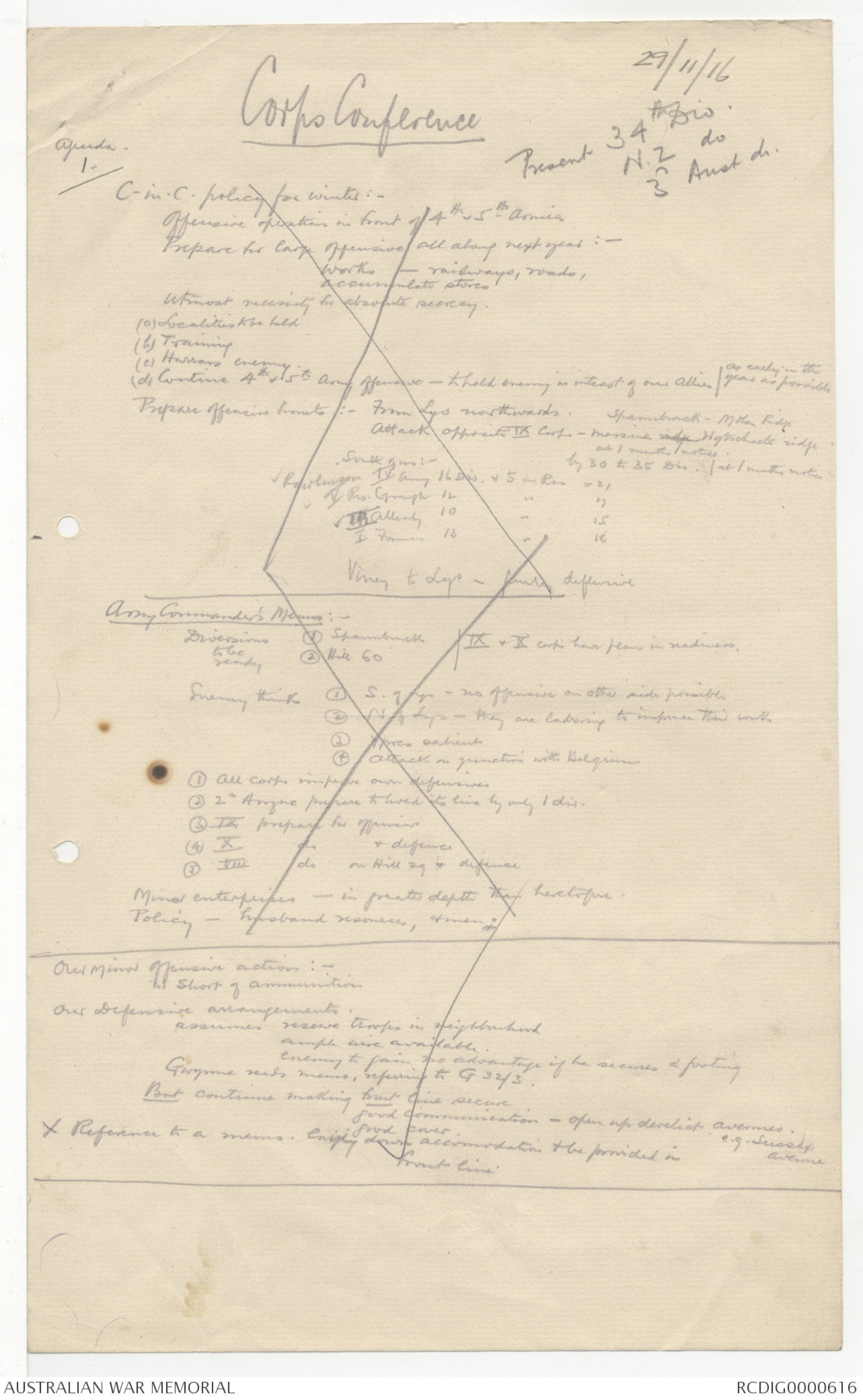
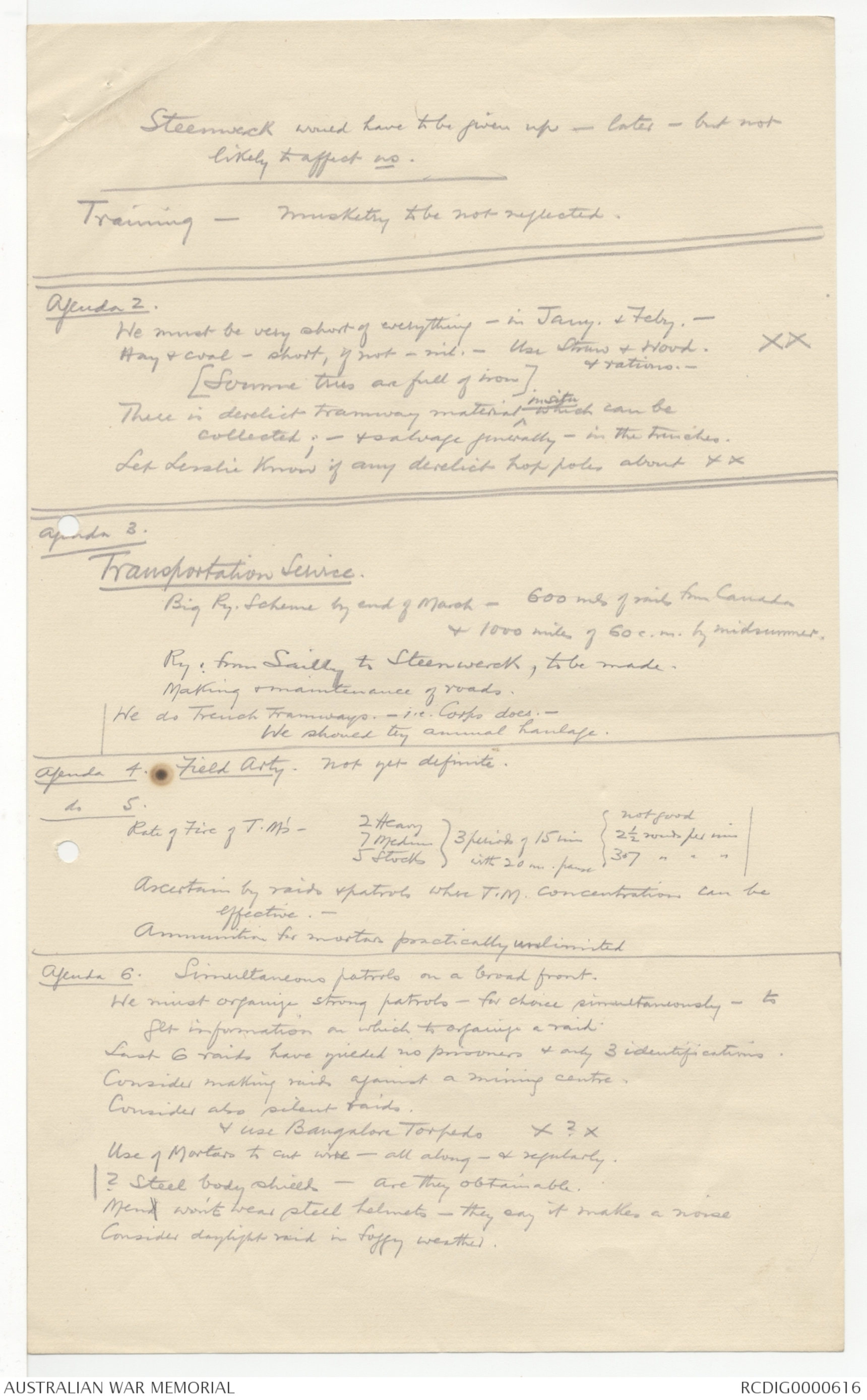
DISTRIBUTION . OF. THE. D.A.C.
FOR. THE. SUPPLY. OF . AMMUNITION
Diagram - see original document
3rd AUST. DIV. ARTY. H.QRS A.I.F.
Date 16/11/16
No.
"A" Form. Army Form C. 2121.
MESSAGES AND SIGNALS. No. of Message...
Prefix Code m.
Office of Origin and Service Instructions
Copy
Words Charge
Sent
At..................m.
To .................
By .................
This message is on a/c of:
.........................................Service.
..........................................
(Signature of "Franking Officer").
Recd. at..........................m.
Date 21/11/16
From .................
By ........................
TO Military Secretary
War Office London
Sender's Number. AQ 145
Day of Month 21
In reply to Number.
AAA
Your 3201 MS 1 aaa
G.O.C. 3rd Australian Division
will proceed to France on
Friday 24th. aaa unable to
leave earlier owing to urgent
Divisional matters aaa
Addressed Military Secretary
War Office repeated Adminaust
London.
From 3rd Australian Division
Place
Time Larkhill
SECRET.
2nd AUSTRALIAN AND NEW ZEALAND ARMY CORPS.
GENERAL STAFF CIRCULAR No. 14.
25th November, 1916.
Rules for the employment of 'S.O.S.' call and action to be taken thereon.
All previous instructions as regards the 'S.O.S.' call
are cancelled and the following will be substituted :-
1. The 'S.O.S.' is the call for immediate assistance from
the artillery to cover any portion of the front line threatened.
It should be clearly understood that it should be given when
the circumstances are such that an enemy attack appears probable.
It is not necessary to wait until the enemy's infantry is seen
to be advancing.
The 'S.O.S.' would be used in case of an intense bombardment,
when NO MAN"S LAND and the enemy's parapet cannot
be observed. When, however, observation is good and there
is no indication of the enemy advancing, a call for retaliation
should suffice.
2. The signal can be given by any Officer on duty in the
front line.
3. The signal will be sent by telephone from the nearest
signal office on the special 'S.O.S.' line, or, if that is out,
by any other connection available. The message should take
the following form -
"S.O.S. TRENCH ............."
Every Officer in the front line will carry the 'S.O.S.'
message for his section written out ready to hand in to the
signal office.
4. The call will be duplicated by the use of the 'S.O.S.'
rocket, supplies of which will be kept in every Officer's dugout
in the front line, and at Company Headquarters.
The 'S.O.S.' is an Asteroid Rocket, the colour of which
may be changed from time to time under instructions from the
Army.
The Officer calling for assistance will continue to
send up rockets till assistance is given.
5. The response to the 'S.O.S.' should be made by the
covering group, R.F.A., which will bombard the enemy's trenches
with its howitzers and place a shrapnel barrage as near to our
own trenches as safety permits. After 2 minutes' intense
fire, this barrage will creep by lifts of 50 yards at 1 minute
intervals till it reaches the enemy's trenches, when it will
become stationary and H.E. may be substituted wholly or partly
for shrapnel. Rate of fire to be decided by Divisional
Commanders according to the number of guns available.
"Heavy Artillery Barrage". This will be superimposed
upon the former at the discretion of the Division Commander,
when from the reports that have reached him he considers that
a serious attack is impending. It should take the form of
bombardment of the enemy trenches by heavy howitzers and 60-prs.,
with a view to breaking up a threatened attack. Plans for such
action should have been previously formulated by Corps with
reference to the different sectors of the Corps front, and should
be put /
P.T.O.
[*GOC*]
(2)
be put into operation upon receipt of the necessary information
from the Division by the Brigadier General Commanding Corps
Heavy Artillery. The latter should further exercise his own
initiative in anticipating such calls should information reach
him first indicating the probability of such an attack.
"Counter-Battery Work". All heavy artillery not
required for barrage should be allotted to counter-battery work,
on a preconceived plan, and the assistance of the 11th Heavy
Artillery Group should be demanded, upon a plan, the details of
which should have been previously arranged between Commanders
of Corps Heavy Artillery and the Officer Commanding 11th Heavy
Artillery Group.
6. The above rules will come into force from 12 noon
December 1st, 1916.
S. B. Pope Capt:
for B.G.,G.S.,
2nd ANZAC Corps.
Distribution - Copies
Right Sector (N.Z.Div.) 40
Centre Sector (34th Div.) 40
Left Sector (3rd Aust.Div.) 40
B.G.,R.A.(2nd ANZAC) 15
27 Nov. /1916
Dear Warren
The Ammn required to be held
on charge at each gun & which I have is
as follows.
| 18lbs | 4.5 Hows | |
| Dug in at gun | 254 | 154 |
| Gun limbers | 24 | 12 |
| Firing Batry Wagon | 48 | |
| 1st Line Wagon | 76 | 48 |
| 354 | 264 |
In addition to
this I have left for the remaining 4 days of this
period from the allotment 700 18lbs & 609 4.5
How rounds not allowing from what heavy have
been fired since 12 noon today.
I left a note book on the GOC's mantlepiece - may
the orderly bring it back?
Yours
L.G. Thompson
28/11/16
Arty Ammn
We are alloted 1/3 of Corps supply every 10 days
Last lot - 1500 / 18 pr/
800/ How / all H.E.
Short of Shrapnel -: fire 25% of total
Not enough for raids;
Has now about 200 with guns & 100 in wagons - as a Reserve.
S.O.S. is a defensive operation which Corps recognise.-
X Ask for my D.A.C. to be filled up. -
| At present | 3 rounds per day per gun 18pr | ||
| 15 rounds per day per How | |||
| 18pr | 30x10x3 | = | 900 |
| Margin | 600 | ||
| 1500 | |||
| Hw | 2btys x 10dysx 30rds | = | 600 |
| Margin | 200 | ||
| 800 | |||
29/11/16
Secret
Precis of statement by Corps Commander
at Conference of 29/11/16.
The Commander - in - Chief's policy for the winter is to maintain offensive
operations in the fronts of the 4th & 5th Armies, and to prepare
for an offensive on a large scale all along the front next year
There is the utmost necessity for absolute secrecy as to what these
plans are.-
The preparations referred to include the accumulation of ammunition
& stores, & the construction of roads & railways
Decisions will be made as to localities to be held, training of
troops for the offensive, continuation of operations to harass the enemy
& a continuation of the 4th & 5th Army offensive, so as to hold the
enemy on the Somme & Ancre, in the interests of our Allies. This latter
is to be done as early in the year as possible.
We must all be prepared for certain offensive fronts. The whole of these
have not been specified, except one from the Lys northwards, in
which front there would is to be an attack opposite present front of the IX Corps
on the Messines - Wytschaete Ridge;- this offensive is to be prepared
so as to be ready at 1 month's notice. It will be carried out by
30 to 35 Divisions.
To the South of the Lys the dispositions will be
| First Army | (Horne) | 13 Divs | with 5 in Reserve | = | 18 | |
| Third do | (Allenby) | 10 " | " 5 " | = | 15 | |
| Reserve do | (Gough) | 12 " | " 5 " | = | 17 | |
| Fourth do | (Rawlinson) | 16 " | " 5 " | = | 21 | |
| 71 |
From Vimy to the Lys (22½ miles) our line is to remain purely
on the defensive.-
Upon the above policy, the Army Commander has laid down that
Diversions are to be got ready by IX & X Corps, for attacks on
the Spannbroeck ridge & Hill 60.
His appreciation is that the enemy considers that south of the
Lys there is no offensive possible by either side; north of the Lys
an attack by no is probable & he is laboring to improve his
works there; he may also contemplate an attack on the Ypres
Salient, or on our junction with the Belgians
The Army Commanders instructions are therefore as follows:-
All Corps in the army will improve their own defensive
2nd Anzac will arrange to hold its line with only one Division.
IX Corps will prepare for an offensive
X " " " for an offensive & for local defence.
VIII " " " " " " on Hill 29 & for local defence.
Minor enterprises will have to be carried out, & must be in greater
depth than heretofore
The Policy of II Army is to husband resources, both in men & in
material.
29/11/16
Corps Conference
[*Present 34th Div,
N.Z dv
3d Aust dv.*]
Agenda.
1.
C-in-C. policy for winter:-
Offensive operation in front of 4th & 5th Armies.
Prepare for Corp Offensive all along next year:-
Works - railways, roads,
accumulate stores
Utmost necessity for absolute secrecy.
(a) Localities to be held
(b) Training
(c) Harrass enemy
(d) Continue 4th & 5th Army offensive - to hold enemy in interest of our Allies
[*As early in the
year as possible*]
Prepare offensive fronts:-
From Lys northwards. - Spannbroeck - Molen Ridge
Attack opposite IX Corps - Messines ridge- Wytschaete Ridge
at 1 months notice.
by 30 to 35 Div. at 1 months notice
South Guns -
Rawlinson IV Army 16 Div & 5 in Res = 21
V Res. Gough 12 " 17
III Allenby 10 " 15
I Turner 13 " 18
Vimy to Lys - final defensive
Army Commander's Memmo:-
Diversions to be ready
(1) Spannbroeck IX & X corps have plans in readiness
(2) Hill 60
Enemy think
(1) S.of Lys - no offensive on other side possible
(2) N of Lys - they are laboring to improve their works
(3) Ypres Salient
(4) Attack on junction with Belgium
(1) All corps improve own defensives
(2) 2 [[A?]]prepare to hold its line by only 1 div.
(3) IX prepare for offensive
(4) X do & defence
(5) VIII do on Hill 29 & defence
Minor enterprises - in greater depth than heretofore.
Policy - Husband resources, & men.
Our Minor offensive action:-
Short of ammunition
Our Defensive arrangements.
Assumes reserve troops in neighbourhood
ample wire available.
enemy to gain no advantage if he secures a footing
Gwynne reads memo, referring to G 32/3.
Bnt continue making front line secure.
good communication - open up derelict avenues
e.g. Sussex avenue
good cover
X Reference to a memo. [[?]] down accommodation & be provided in
front line.
Steenwick would have to be given up - later - but not
likely to affect no.
Training - Musketry to be not neglected.
Agenda 2.
We must be very short of everything - in Janry. & Febry. -
Hay & coal - short, if not - nil. - Use straw & wood. XX
& rations.-
[Somme trees are full of iron]
There in derelict tramway material ^ insitu which can be
collected; - & salvage generally - in the trenches.
Let Lerslie Know if any derelict hop poles about xx
Agenda 3.
Transportation Service.
Big Ry. Scheme by end of March - 600 mls of rails from Canada
& 1000 miles of 60c.m. by midsummer.
Ry. from Sailly to Steenwerck, to be made.
Making & maintenance of roads.
We do Trench Tramways. - i.e. Corps does. -
We should try annual haulage.
Agenda 4. Field Arty. Not yet definite.
do 5.
Rate of Fire of T.M's -
| 2 Heavy | not good | |
| 7 Medium | 3 periods of 15 min with 20min pause |
2½ rounds per min |
| 5 Stocks | 3.7 " " " |
Ascertain by raids & patrols where T.M. concentration can be
effective.-
Ammunition for mortars practically unlimited
Agenda 6. Simultaneous patrols on a broad front.
We must organise strong patrols - for choice simultaneously - to
get information on which to organise a raid.
Last 6 raids have yielded no prisoners & only 3 identifications.
Consider making raids against a mining centre.
Consider also silent raids.
& use Bangalore Torpedo X?X
Use of Mortars to cut wire - all along - & regularly.
? Steel body shields - are they obtainable.
Mend won't wear steel helmets - they say it makes a noise
Consider daylight raid in foggy weather.
 Deb Parkinson
Deb ParkinsonThis transcription item is now locked to you for editing. To release the lock either Save your changes or Cancel.
This lock will be automatically released after 60 minutes of inactivity.